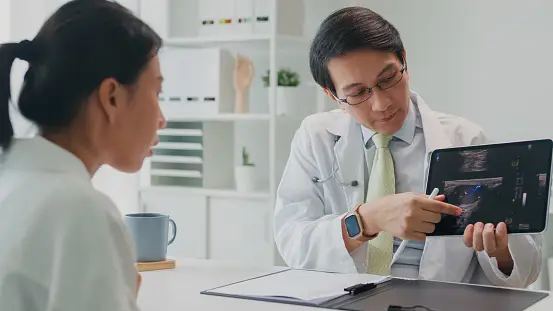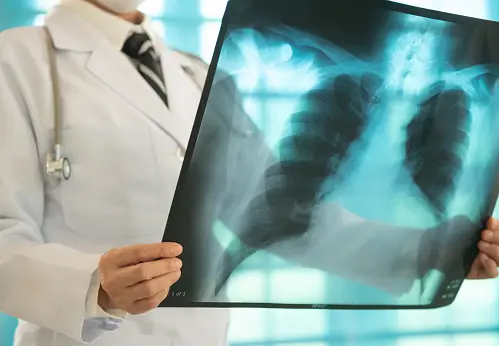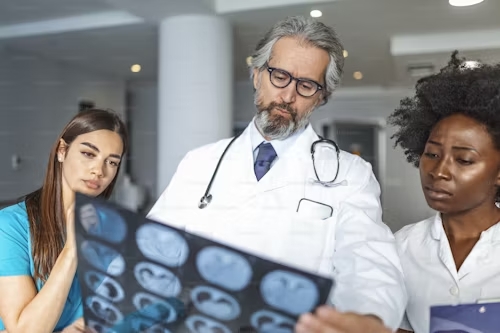A medical professional may screen for lung cancer using a variety of diagnostic techniques, such as imaging studies and physical examinations. Blood work will not reveal lung cancer, but your results may point to other health issues. A medical professional can better comprehend your symptoms, the kind of cancer you have, and the extent of your illness with the aid of these tests.
When lung cells proliferate uncontrollably and develop into malignancy, lung cancer results. The cancer cells have the potential to travel to the brain, lymph nodes, and other organs as the disease worsens. If you believe you have symptoms or are at risk of developing lung cancer, it’s a good idea to be checked. The illness can spread swiftly.
To rule out other disorders and give you an official diagnosis, a healthcare practitioner may meet with a team consisting of an oncologist, who treats cancer, and a pulmonologist, who treats lung diseases. It can be frightening to get tested for lung cancer. Early diagnosis can facilitate a quicker onset of treatment.
Table of Contents
Lung Cancer Types
Small-cell lung cancer (SCLC) and non-small-cell lung cancer (NSCLC) are the two forms of lung cancer. Through testing, a healthcare provider can identify your kind.
Health History and Physical Examination

Your consultation will begin with a physical examination and a discussion of your medical history with your healthcare practitioner. By taking this initial step, they can better comprehend your symptoms and search for any lung cancer indicators.
A medical professional might inquire:
- Is your cough becoming worse?
- Have you experienced breathing difficulties?
- Do you have blood in your cough or are you naturally losing weight?
- Which other symptoms do you experience?
- For what duration have you been undergoing symptoms?
- Is there a member in your family that has lung cancer?
- Do you smoke now or have you ever used tobacco products personally?
- Have you experienced any infections related to your lungs recently?
A healthcare professional may also inquire about your lifestyle, including your diet and level of activity. They could be interested in knowing what you do for a living and where you work because exposure to chemicals can also raise your risk of lung cancer. There may be high airborne concentrations of asbestos, radon, or secondhand smoking in some places of employment.
Next, a medical professional will do a standard physical examination, which probably entails the following:
- Examining your extremities (hands and feet), stomach, and chest for any pain, weakness, or swelling.
- Taking your blood pressure, heart rate, and temperature, among other vital signs.
- Taking your body’s temperature
It takes more than just a physical examination and information about your medical history to identify lung cancer in you. A healthcare provider can use these stages to determine the best course of action and, if necessary, order more testing.
Blood Tests

Lung cancer cannot be diagnosed by blood testing alone. It is usual practice to get blood tested because it can provide a healthcare practitioner a basic idea of your health. A complete blood count (CBC) will often be displayed on your blood test. Any issues with the quantity of platelets, red blood cells, white blood cells, and other cell types may be identified by this test.
If something in your blood tests doesn’t look normal, a healthcare physician may order blood chemistry testing for additional assessment. A blood chemistry test looks at your organs’ cells. The function of your kidneys, liver, and other main organs can be examined by this test. Test results that are abnormal may indicate that the disease has spread to organs other than the lungs.
You might be required to have routine blood tests if you are diagnosed with cancer. Regular blood tests can assist a medical professional in monitoring your general health and understanding how well your treatment is working.
Imaging Tests

Imaging examinations use X-rays, magnetic fields, or sound waves to produce detailed images of your lungs. These tests can determine whether you have a tumor or cancer cells, as well as the extent of the cancer’s spread and the efficacy of your treatment.
A medical professional may request one or more of the imaging examinations listed below:
| TYPE OF IMAGING TEST | DESCRIPTION |
| Bone scan | Ascertains whether the cancer has progressed to your bones. |
| Chest X-ray | Uses radiography to examine the organs’ structures in the chest |
| Computed tomography (CT) scan | Combines many X-ray pictures to provide a more thorough view of the lungs, any possible malignancies, and enlarged lymph nodes. |
| Magnetic resonance imaging (MRI) | Takes pictures of the soft tissue in your chest using radio waves and magnets to see if the cancer has spread to other organs. |
| Positron emission tomography (PET) scan | Uses an IV to inject a harmless radioactive substance intravenously (to check for chemical changes in your cells and organs). |
Lab Testing

Your health can be better understood by a healthcare provider with the use of blood and imaging testing. Laboratory studies that examine your lung cells are necessary for an official diagnosis of lung cancer. A medical professional may employ a variety of laboratory tests to diagnose lung cancer and determine the extent of the cancer’s spread.
Diagnostic Tests

Under a microscope, a lab worker will use a sample of your lung cells to run tests. A medical professional may prescribe the following lab tests to confirm a diagnosis of lung cancer:
- Biopsy: This involves taking a sample of lung tissue with a needle. The sample will then be examined under a microscope by a lab professional to look for cancerous cells.
- Bronchoscopy: A tiny, flexible tube that is connected to a camera allows you to see into your lungs. A bronchoscopy examines your airways to look for malignancies or obstructions.
- Sputum cytology: A medical professional will ask you to cough up a sample of your sputum, or lung mucus, in order to examine it for the presence of cancerous cells.
- Thoracentesis: Pleural effusions, or fluid accumulation surrounding the lungs, can affect certain individuals. This test can be carried out by a medical professional by numbing the skin and taking a fluid sample through the chest with a tiny needle or catheter. To find out what is causing the build-up, a lab technician can test the fluid.
Tests for the Spread of Cancer

A medical professional would probably request more testing if they discover cancer cells in order to determine whether the disease has spread, or metastasized. Laboratory testing can provide information on the spread of cancer cells and guide treatment decisions. During these tests, a tiny tube with a camera and tiny light attached is inserted within your body. This facilitates the examination of cancer cells in various organs and systems.
A medical professional may request one or more of the subsequent examinations:
- Endobronchial ultrasound: In order to search for cancer cells between the lungs and around the breastbone, this treatment moves the tube down the neck.
- Endoscopic esophageal ultrasound: The purpose of this ultrasonography is to look for cancer cells in the lymph nodes that are close to your throat.
- Mediastinoscopy or mediastinotomy: This examination inserts a tube beneath the breastbone to look for cancerous cells in the mediastinum, which encompasses the windpipe, the esophagus, and the heart.
- Thoracoscopy: The purpose of this test is to look for cancer cells that have moved from the lungs into the chest by inserting a catheter beneath your shoulder blades.
Lung Function Test

After diagnosing lung cancer, a medical professional may prescribe a pulmonary function test, or pulmonary function test (PFT). Your ability to breathe can be determined by a lung function test.
Lung function tests come in a variety of forms, but they all typically follow the same guidelines. Breathing through a tube that is attached to a device that monitors airflow will be your experience.
This test informs a medical professional about the safety of lung surgery. Depending on the kind of cancer you have, surgery might be a part of your care. The results of the lung function test determine how much lung tissue a surgeon can remove if necessary for your course of treatment.
Lung Cancer Stages
If you are diagnosed with lung cancer, your healthcare professional will identify your current stage of the disease. The location of your cancer cells and the size of your tumor determine the stage. Treatment choices will depend on your cancer stage.
SCLC and NSCLC cancers are in various phases of the disease. The SCLC phases are:
- Limited stage: The lungs contain cancer cells.
- Extensive stage: Beyond the lungs, cancer cells have invaded other organs including lymph nodes.
The NSCLC has numbered stages, which include of:
- Stage 0: Although they are not yet in the lung tissue, cancer cells are present in the lining of the lungs.
- Stage 1: A little tumor, measuring less than 3 centimeters (cm), has grown from the cancer cells.
- Stage 2: More than three centimeters of tumor has grown, and cancer cells have invaded neighboring lymph nodes.
- Stage 3: Cancer cells have invaded adjacent chest organs.
- Stage 4: Any size tumor is possible, and cancer cells have invaded lung tissue as well as adjacent or distant organs.
Screening for Related Conditions
Symptoms of other illnesses can occasionally resemble those of lung cancer. Testing will also be used by a medical professional to rule out further conditions, such as:
| CONDITION | DESCRIPTION |
| Bronchitis | Infection of the bronchial tubes in the lungs |
| Granuloma | Non-cancerous inflammation of the lungs |
| Hamartoma | Non-cancerous growth of abnormal lung cells |
| Pleural effusion (caused by other conditions) | Accumulation of fluid around and inside the lungs |
| Pneumonia | Lung inflammation brought on by bacteria, fungus, or viruses in one or both lungs |
| Pneumothorax | Air accumulation in the pleural cavity, or the area between your lungs and chest cavity, which can lead to a partial or total collapse of your lungs. |
| Tuberculosis | Bacterial infection in the lungs |
An Overview
Depending on the kind of cancer, where it is located, and its stage, lung cancer symptoms might change. Getting tested is a good idea if you suspect you could have lung cancer or if symptoms start to appear.
During your diagnostic process, a pulmonologist and oncologist will collaborate with a healthcare provider to perform various tests. Blood and imaging tests, as well as a physical examination, are common examinations for lung cancer. By ruling out alternative illnesses and confirming a diagnosis, these tests can be helpful.
Given the deadly nature of lung cancer, getting tested can be unsettling. To feel overwhelmed is acceptable. Keep in mind that managing your illness and selecting the best course of therapy are made easier with an early diagnosis.
